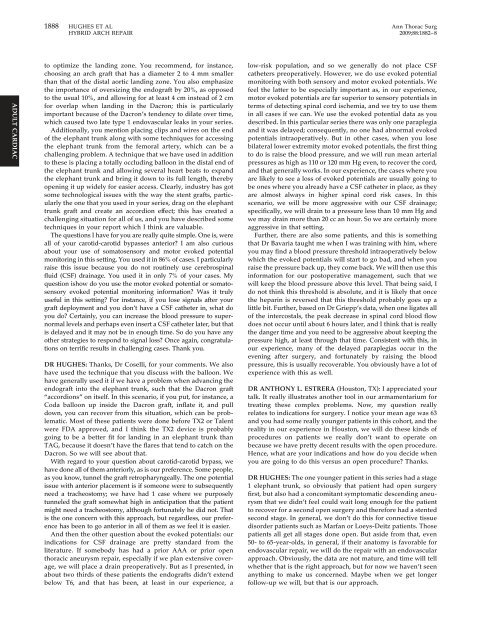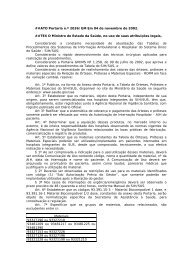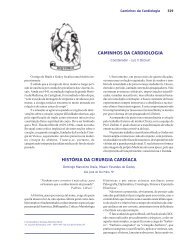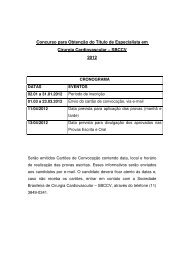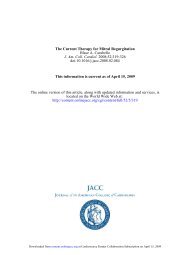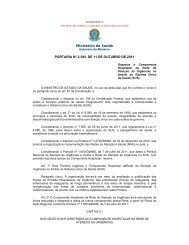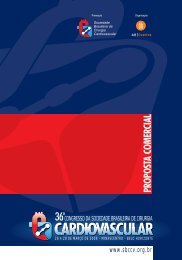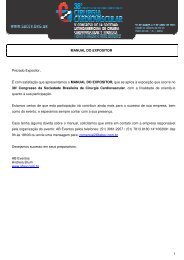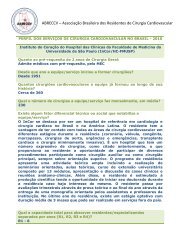“Hybrid” Repair of Aneurysms of the Transverse Aortic Arch: Midterm ...
“Hybrid” Repair of Aneurysms of the Transverse Aortic Arch: Midterm ...
“Hybrid” Repair of Aneurysms of the Transverse Aortic Arch: Midterm ...
Create successful ePaper yourself
Turn your PDF publications into a flip-book with our unique Google optimized e-Paper software.
1888 HUGHES ET AL Ann Thorac Surg<br />
HYBRID ARCH REPAIR 2009;88:1882–8<br />
ADULT CARDIAC<br />
to optimize <strong>the</strong> landing zone. You recommend, for instance,<br />
choosing an arch graft that has a diameter 2 to 4 mm smaller<br />
than that <strong>of</strong> <strong>the</strong> distal aortic landing zone. You also emphasize<br />
<strong>the</strong> importance <strong>of</strong> oversizing <strong>the</strong> endograft by 20%, as opposed<br />
to <strong>the</strong> usual 10%, and allowing for at least 4 cm instead <strong>of</strong> 2 cm<br />
for overlap when landing in <strong>the</strong> Dacron; this is particularly<br />
important because <strong>of</strong> <strong>the</strong> Dacron’s tendency to dilate over time,<br />
which caused two late type 1 endovascular leaks in your series.<br />
Additionally, you mention placing clips and wires on <strong>the</strong> end<br />
<strong>of</strong> <strong>the</strong> elephant trunk along with some techniques for accessing<br />
<strong>the</strong> elephant trunk from <strong>the</strong> femoral artery, which can be a<br />
challenging problem. A technique that we have used in addition<br />
to <strong>the</strong>se is placing a totally occluding balloon in <strong>the</strong> distal end <strong>of</strong><br />
<strong>the</strong> elephant trunk and allowing several heart beats to expand<br />
<strong>the</strong> elephant trunk and bring it down to its full length, <strong>the</strong>reby<br />
opening it up widely for easier access. Clearly, industry has got<br />
some technological issues with <strong>the</strong> way <strong>the</strong> stent grafts, particularly<br />
<strong>the</strong> one that you used in your series, drag on <strong>the</strong> elephant<br />
trunk graft and create an accordion effect; this has created a<br />
challenging situation for all <strong>of</strong> us, and you have described some<br />
techniques in your report which I think are valuable.<br />
The questions I have for you are really quite simple. One is, were<br />
all <strong>of</strong> your carotid-carotid bypasses anterior I am also curious<br />
about your use <strong>of</strong> somatosensory and motor evoked potential<br />
monitoring in this setting. You used it in 86% <strong>of</strong> cases. I particularly<br />
raise this issue because you do not routinely use cerebrospinal<br />
fluid (CSF) drainage. You used it in only 7% <strong>of</strong> your cases. My<br />
question ishow do you use <strong>the</strong> motor evoked potential or somatosensory<br />
evoked potential monitoring information Was it truly<br />
useful in this setting For instance, if you lose signals after your<br />
graft deployment and you don’t have a CSF ca<strong>the</strong>ter in, what do<br />
you do Certainly, you can increase <strong>the</strong> blood pressure to supernormal<br />
levels and perhaps even insert a CSF ca<strong>the</strong>ter later, but that<br />
is delayed and it may not be in enough time. So do you have any<br />
o<strong>the</strong>r strategies to respond to signal loss Once again, congratulations<br />
on terrific results in challenging cases. Thank you.<br />
DR HUGHES: Thanks, Dr Coselli, for your comments. We also<br />
have used <strong>the</strong> technique that you discuss with <strong>the</strong> balloon. We<br />
have generally used it if we have a problem when advancing <strong>the</strong><br />
endograft into <strong>the</strong> elephant trunk, such that <strong>the</strong> Dacron graft<br />
“accordions” on itself. In this scenario, if you put, for instance, a<br />
Coda balloon up inside <strong>the</strong> Dacron graft, inflate it, and pull<br />
down, you can recover from this situation, which can be problematic.<br />
Most <strong>of</strong> <strong>the</strong>se patients were done before TX2 or Talent<br />
were FDA approved, and I think <strong>the</strong> TX2 device is probably<br />
going to be a better fit for landing in an elephant trunk than<br />
TAG, because it doesn’t have <strong>the</strong> flares that tend to catch on <strong>the</strong><br />
Dacron. So we will see about that.<br />
With regard to your question about carotid-carotid bypass, we<br />
have done all <strong>of</strong> <strong>the</strong>m anteriorly, as is our preference. Some people,<br />
as you know, tunnel <strong>the</strong> graft retropharyngeally. The one potential<br />
issue with anterior placement is if someone were to subsequently<br />
need a tracheostomy; we have had 1 case where we purposely<br />
tunneled <strong>the</strong> graft somewhat high in anticipation that <strong>the</strong> patient<br />
might need a tracheostomy, although fortunately he did not. That<br />
is <strong>the</strong> one concern with this approach, but regardless, our preference<br />
has been to go anterior in all <strong>of</strong> <strong>the</strong>m as we feel it is easier.<br />
And <strong>the</strong>n <strong>the</strong> o<strong>the</strong>r question about <strong>the</strong> evoked potentials: our<br />
indications for CSF drainage are pretty standard from <strong>the</strong><br />
literature. If somebody has had a prior AAA or prior open<br />
thoracic aneurysm repair, especially if we plan extensive coverage,<br />
we will place a drain preoperatively. But as I presented, in<br />
about two thirds <strong>of</strong> <strong>the</strong>se patients <strong>the</strong> endografts didn’t extend<br />
below T6, and that has been, at least in our experience, a<br />
low-risk population, and so we generally do not place CSF<br />
ca<strong>the</strong>ters preoperatively. However, we do use evoked potential<br />
monitoring with both sensory and motor evoked potentials. We<br />
feel <strong>the</strong> latter to be especially important as, in our experience,<br />
motor evoked potentials are far superior to sensory potentials in<br />
terms <strong>of</strong> detecting spinal cord ischemia, and we try to use <strong>the</strong>m<br />
in all cases if we can. We use <strong>the</strong> evoked potential data as you<br />
described. In this particular series <strong>the</strong>re was only one paraplegia<br />
and it was delayed; consequently, no one had abnormal evoked<br />
potentials intraoperatively. But in o<strong>the</strong>r cases, when you lose<br />
bilateral lower extremity motor evoked potentials, <strong>the</strong> first thing<br />
to do is raise <strong>the</strong> blood pressure, and we will run mean arterial<br />
pressures as high as 110 or 120 mm Hg even, to recover <strong>the</strong> cord,<br />
and that generally works. In our experience, <strong>the</strong> cases where you<br />
are likely to see a loss <strong>of</strong> evoked potentials are usually going to<br />
be ones where you already have a CSF ca<strong>the</strong>ter in place, as <strong>the</strong>y<br />
are almost always in higher spinal cord risk cases. In this<br />
scenario, we will be more aggressive with our CSF drainage;<br />
specifically, we will drain to a pressure less than 10 mm Hg and<br />
we may drain more than 20 cc an hour. So we are certainly more<br />
aggressive in that setting.<br />
Fur<strong>the</strong>r, <strong>the</strong>re are also some patients, and this is something<br />
that Dr Bavaria taught me when I was training with him, where<br />
you may find a blood pressure threshold intraoperatively below<br />
which <strong>the</strong> evoked potentials will start to go bad, and when you<br />
raise <strong>the</strong> pressure back up, <strong>the</strong>y come back. We will <strong>the</strong>n use this<br />
information for our postoperative management, such that we<br />
will keep <strong>the</strong> blood pressure above this level. That being said, I<br />
do not think this threshold is absolute, and it is likely that once<br />
<strong>the</strong> heparin is reversed that this threshold probably goes up a<br />
little bit. Fur<strong>the</strong>r, based on Dr Griepp’s data, when one ligates all<br />
<strong>of</strong> <strong>the</strong> intercostals, <strong>the</strong> peak decrease in spinal cord blood flow<br />
does not occur until about 6 hours later, and I think that is really<br />
<strong>the</strong> danger time and you need to be aggressive about keeping <strong>the</strong><br />
pressure high, at least through that time. Consistent with this, in<br />
our experience, many <strong>of</strong> <strong>the</strong> delayed paraplegias occur in <strong>the</strong><br />
evening after surgery, and fortunately by raising <strong>the</strong> blood<br />
pressure, this is usually recoverable. You obviously have a lot <strong>of</strong><br />
experience with this as well.<br />
DR ANTHONY L. ESTRERA (Houston, TX): I appreciated your<br />
talk. It really illustrates ano<strong>the</strong>r tool in our armamentarium for<br />
treating <strong>the</strong>se complex problems. Now, my question really<br />
relates to indications for surgery. I notice your mean age was 63<br />
and you had some really younger patients in this cohort, and <strong>the</strong><br />
reality in our experience in Houston, we will do <strong>the</strong>se kinds <strong>of</strong><br />
procedures on patients we really don’t want to operate on<br />
because we have pretty decent results with <strong>the</strong> open procedure.<br />
Hence, what are your indications and how do you decide when<br />
you are going to do this versus an open procedure Thanks.<br />
DR HUGHES: The one younger patient in this series had a stage<br />
1 elephant trunk, so obviously that patient had open surgery<br />
first, but also had a concomitant symptomatic descending aneurysm<br />
that we didn’t feel could wait long enough for <strong>the</strong> patient<br />
to recover for a second open surgery and <strong>the</strong>refore had a stented<br />
second stage. In general, we don’t do this for connective tissue<br />
disorder patients such as Marfan or Loeys-Deitz patients. Those<br />
patients all get all stages done open. But aside from that, even<br />
50- to 65-year-olds, in general, if <strong>the</strong>ir anatomy is favorable for<br />
endovascular repair, we will do <strong>the</strong> repair with an endovascular<br />
approach. Obviously, <strong>the</strong> data are not mature, and time will tell<br />
whe<strong>the</strong>r that is <strong>the</strong> right approach, but for now we haven’t seen<br />
anything to make us concerned. Maybe when we get longer<br />
follow-up we will, but that is our approach.


